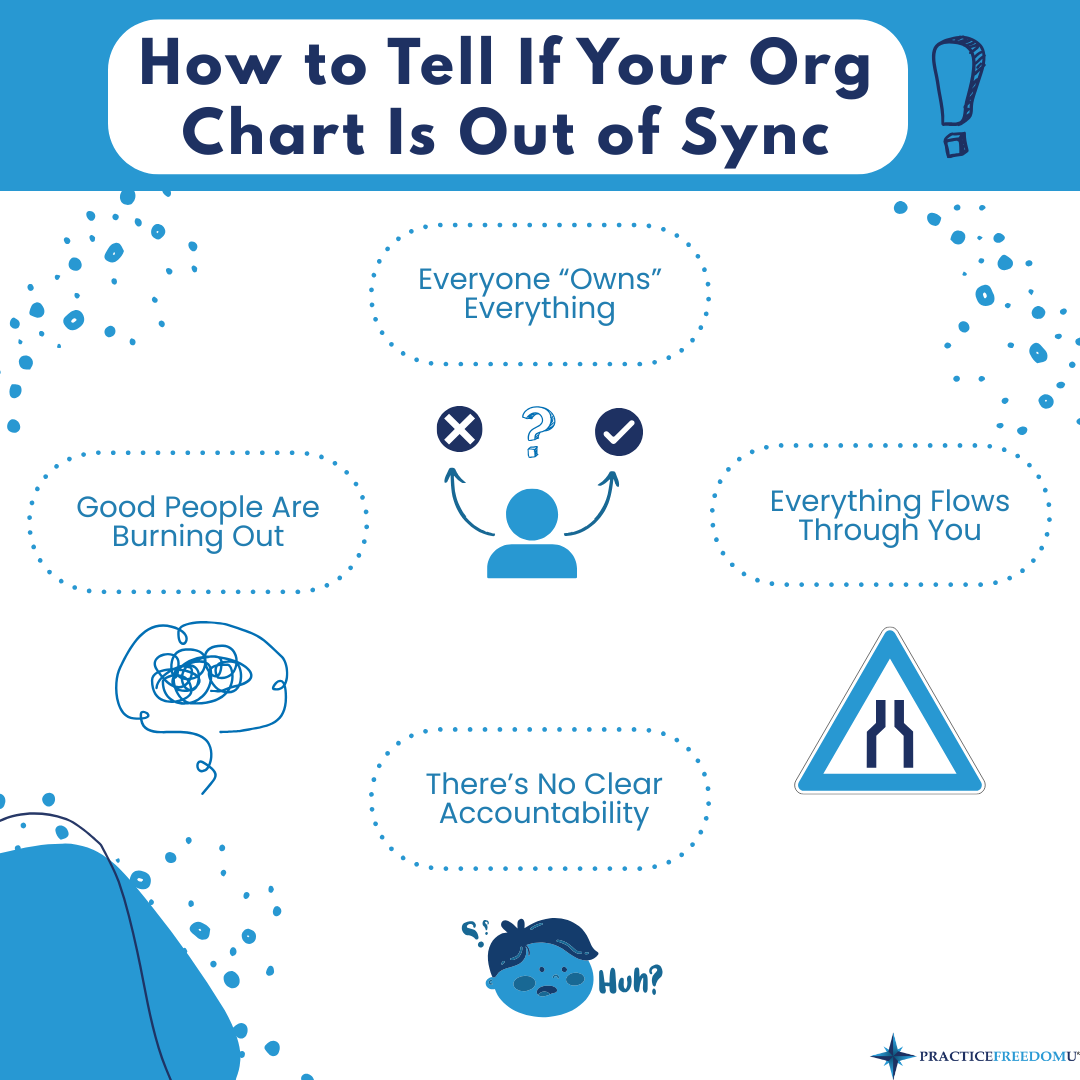Take a look at the org chart in your practice, if you even have one. Does it reflect how things actually work day to day? Or is it just a document collecting dust in a shared folder?
In many growing practices, there’s a dangerous disconnect between what’s on paper and what’s actually happening. Titles exist, but responsibilities overlap. Authority is murky. Decisions stall. Or worse, fall to you every time. This misalignment isn’t just annoying. It’s expensive.
Let’s talk about why your org chart might not reflect reality, how it’s holding your business hostage, and most importantly how to fix it.
The Illusion of Structure
In the early stages, wearing multiple hats is normal. You adapt. You hustle. You do what needs to be done.
But that same startup energy becomes a liability as your business grows. When your team hits 15 or 20 people, your seat-of-the-pants structure starts breaking down. People duplicate tasks. Others drop the ball. Tension builds, and you’re the one putting out fires.
The org chart might look nice, but if it doesn’t match reality, it’s not helping. It’s hurting.

How to Tell If Your Org Chart Is Out of Sync
Here are some warning signs:
1. Everyone “Owns” Everything
You hear:
“I thought she was doing that.”
“No one told me it was mine.”
“Wait—was that my responsibility?”
This ambiguity kills productivity and fuels resentment.
2. Everything Flows Through You
If every meaningful decision ends up on your plate, your managers aren’t truly managing. They’re asking for permission, not acting with authority. (Forbes)
3. There’s No Clear Accountability
When things go wrong, it’s unclear who’s responsible. That’s a leadership issue, not a performance issue.
4. Employees Are Disengaged or Frustrated
Your top team members want clarity and direction. Without it, they get frustrated or leave.
Why It Happens: Growth Without Structure
Most practice owners build their business around great people, not around roles. That works for a while. But as you grow, relying on personalities instead of systems becomes a liability.
When roles aren’t clearly defined…
When decision-making is inconsistent…
When reporting lines are fuzzy…
…you become the bottleneck. And growth stalls.
The Cost of Misalignment
When your organizational structure doesn’t match reality, here’s what it costs you:
- Confusion: Tasks are dropped, delayed, or duplicated.
- Friction: People overstep—or avoid responsibility altogether. (The New York Times)
- Burnout: You become the default decision-maker for everything.
- Missed Growth: You can’t scale what you can’t structure.
This is the moment where many owners hit the wall. Not because they’re doing something wrong, but because they haven’t yet built the next version of their leadership.
How to Realign Your Organizational Structure
-
Start With Outcomes
-
Define Roles, Not Just Job Titles
-
Rebuild the Org Chart Around Reality
-
Communicate Clearly
-
Develop Real Leaders
What results does each part of your business need to deliver? Billing. Marketing. Patient care. Who owns the result? Start there. Not with titles.
A “clinic manager” means nothing unless you’ve defined what they’re accountable for. What are their 3–5 core responsibilities? What decisions can they make without you?
Design the org chart for the business you want, not just the one you have. Yes, you may wear three hats right now. But at least now you’ll know which ones, and which ones to delegate next.
Don’t just update a chart. Talk to your team. Explain the “why.” Show them how the new structure helps them succeed and lowers their stress.
Don’t promote someone and then second-guess them. Train them. Coach them. Give them the space to lead—and the tools to succeed.
What Alignment Looks Like
When your structure reflects how the business actually operates, everything gets easier:
✅ People know what’s expected
✅ Decisions get made faster
✅ Managers manage
✅ You step out of the weeds
That’s the difference between running a practice and owning a business.
Real Practice, Real Results
One of my clients was running a multi-location practice with nearly 30 staff. She had “managers,” but made every decision herself. Her team relied on her for everything, and she was drowning.
Together, we created outcome-driven roles: Clinical Director, Office Manager, Marketing Coordinator. We clarified responsibilities. We built a new org chart around those outcomes, not titles or tenure.
Six months later, she had cut her daily involvement in half. Her team was stepping up. Morale was rising. And the org chart? It wasn’t just a document. It was how the business operated.
Final Word: Build a Business, Not Just a Job
If your org chart doesn’t reflect reality, you’re not alone. But that doesn’t mean you should stay stuck.
Don’t let misalignment steal your time, energy, or growth.
At Practice Freedom U, we help practice owners restructure their teams, define leadership roles, and build the kind of business that doesn’t depend on them for everything. A business that grows, is sustainable, and sane.
————————————————————-
Are you ready for a coach? Join the hundreds of physical therapy owners who are building the practice of their dreams with the support, guidance and direction of a Practice Freedom U Coach. Take the first step towards creating a business that sets you free by scheduling a Discovery Call



